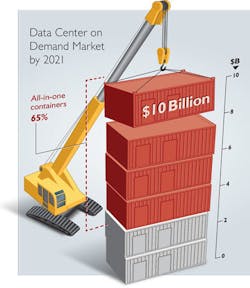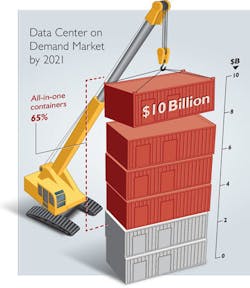Containerized data center market to reach US$10B by 2021
A recently released report from Beige Market Intelligence (beigemarketintelligence.com) examines the market for data centers alternatively called containerized, modular, and, as the analyst calls them in the report, on-demand. “Data Center on Demand (DCoD) Market” provides current market data and forecasts to the year 2021. The report segments modular data centers into three types: facility containers, IT containers, and all-in-one.
As the nomenclature used in this market segment evolves, it is worthwhile to roughly define those three types. In a white paper titled “Types of prefabricated modular data centers,” Schneider Electric senior research analyst Wendy Torell uses the terms “semi-prefabricated, fully prefabricated, all-in-one.” She briefly defines each type as follows.
- Semi-prefabricated-A data center comprised of a combination of prefabricated functional blocks and traditional “stick-built” systems
- Fully prefabricated-A data center comprised completely of prefabricated IT, power, and cooling modules
- All-in-one-A data center that is self-contained in a single enclosure, with IT, power, and cooling systems
Among the high-point projections in Beige’s report is that by the end of the forecast period, the worldwide market for data centers on demand will reach approximately US$10 billion. “All-in-one containers are expected to account for 65 percent of demand, in revenue, for DCoD by 2021,” the firm says. “All-in-one containers account for the major share of the market as of 2015, primarily due to their average selling price (ASP). In terms of unit shipments, however, all-in-one containers are not leading the demand for DCoD as of 2015. The number of all-in-one containers in the U.S. is expected to reach more than 50 by 2019. All-in-one containers are approximately three times the ASP of facility containers as of 2015. The ASP of facility containers is expected to decline during the forecast period. One key reason is that the demand for facility containers in the market will reduce considerably by 2020. Furthermore, the shipment of facility containers is expected to be much lower in comparison to IT and all-in-one containers, which are already proving to have more advantages than a facility container.”
Beige continued, “North America contributes more than 30 percent of the demand for DCoD as of 2015. The vast majority of deployment of DCoD in North America was from the U.S.; the demand for DCoD in the U.S. will remain high during the forecast period due to the requirement for additional capacity to the existing data centers within the country, and also due to the deployment of edge data centers. With business data and computing usage growing at a significant rate, most of the Tier 4 data centers will require additional capacity to power new business applications, thereby creating the demand for DCoD.”

